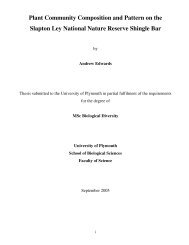de Vere 2007 Biol Flora C. dissectum.pdf - The Whitley Wildlife ...
de Vere 2007 Biol Flora C. dissectum.pdf - The Whitley Wildlife ...
de Vere 2007 Biol Flora C. dissectum.pdf - The Whitley Wildlife ...
- No tags were found...
You also want an ePaper? Increase the reach of your titles
YUMPU automatically turns print PDFs into web optimized ePapers that Google loves.
889Cirsium <strong>dissectum</strong><strong>dissectum</strong> × C. acaule = C. × woodwardii was knownfrom Pen Hill, Swindon, north Wilts between 1848 and1952 and recor<strong>de</strong>d at South Lopham Fen, east Norfolk,in 1953 (K. J. Walker, pers. comm.).flower in predated capitula in three grasslands withinthe Netherlands. Flowering and seed production variedsignificantly over the 5 years that the grasslands weremonitored.(C) SEED PRODUCTION AND DISPERSAL(i) Seed productionMost commonly, only a single capitulum is producedalthough most populations contain some plants withtwo or three capitula. Cirsium <strong>dissectum</strong> is self-compatiblebut selfed capitula produce fewer seeds. Capitula selfedusing a paintbrush showed an 89.4% reduction in thenumber of seeds produced compared to individualsthat were out-crossed using the same method (n = 119;<strong>de</strong> <strong>Vere</strong> <strong>2007</strong>). Within each seed head a number ofhollow seeds without embryos is often found alongsi<strong>de</strong>those that are filled. <strong>de</strong> <strong>Vere</strong> (<strong>2007</strong>) collected 30 seedheads from each of 22 populations throughout theBritish Isles to examine seed production. <strong>The</strong> meannumber of seeds within a seed head was highly variableboth within and between populations. <strong>The</strong> lowestmean number of seeds per capitulum was observed tobe 6.5 (SD 8.5) at Kenfig Burrows in Wales. <strong>The</strong> highestwas at Aylesbeare Common, Devon, with 82.7 (SD28.1). <strong>The</strong> mean air-dry mass per achene (with thepappus removed) varied from 1.32 mg (SD 0.42) at aheathland site in the New Forest to 3.63 (SD 0.99)within a highly productive Schoenus nigricans fen onthe shores of Lough Corrib, Ireland. <strong>The</strong> mean airdryachene mass per population was correlated to theconcentration of phosphorus in the soil (r = 0.42;P < 0.05). Jongejans et al. (2006b) recor<strong>de</strong>d a range of72–94 flowers per capitulum with 0.09–0.49 seeds perflower in unpredated capitula and 0–0.37 seeds per(ii) Seed dispersal<strong>The</strong> pappus often becomes <strong>de</strong>tached before the seed isshed from the capitulum. Wind dispersal occurs in dryconditions as the pappi stick together when they arewet. Rosettes die after flowering and the flowering stemgenerally dries out and thins just below the capitulumcausing the stem to bend over and eventually break,releasing the capitulum often close to the parent plant.This appears to be an additional dispersal mechanismfor the seeds still trapped insi<strong>de</strong>.<strong>de</strong> <strong>Vere</strong> (<strong>2007</strong>) measured the distance travelled byseeds with pappus attached over 2 days at BrauntonBurrows, Devon. On both days wind speed was approximately7–8 m s –1 at 10 m height, with occasional strongergusts. Capitula containing ripe seeds ready for dispersalwere located and seeds with pappus attached gentlydislodged and tracked. Most of the 110 seeds lan<strong>de</strong>dwithin a few metres of the parent plant with only oneseed travelling over 20 m (Fig. 7). Kay & John (1994)investigated seed dispersal at Kenfig, Wales andobserved dispersal distances up to 10 m at wind speedsof approximately 2 m s –1 and up to 20 m at speeds ofaround 3–4 m s –1 .Simulated seed dispersal kernels <strong>de</strong>termined bySoons et al. (2005) show high probabilities of dispersalclose to the parent plant, with dispersal probabilitydropping to zero at approximately 13 m. <strong>The</strong> windspeeds used in the mo<strong>de</strong>l represented the average windspeed distribution during the dispersal season (June toOctober) in the interior of the Netherlands. Simulations© <strong>2007</strong> <strong>The</strong> AuthorJournal compilation© <strong>2007</strong> BritishEcological Society,Journal of Ecology,95, 876–894Fig. 7 Dispersal distances for 110 seeds from 11 capitula of Cirsium <strong>dissectum</strong>. Ripe seeds with pappus attached were dislodgedfrom capitula and tracked. If after landing the seed did not move for 2 min, the distance it had travelled was measured. Seeddispersal was measured over 2 days at Braunton Burrows, Devon, with a wind speed of approximately 7–8 m s –1 and occasionalstronger gusts.




